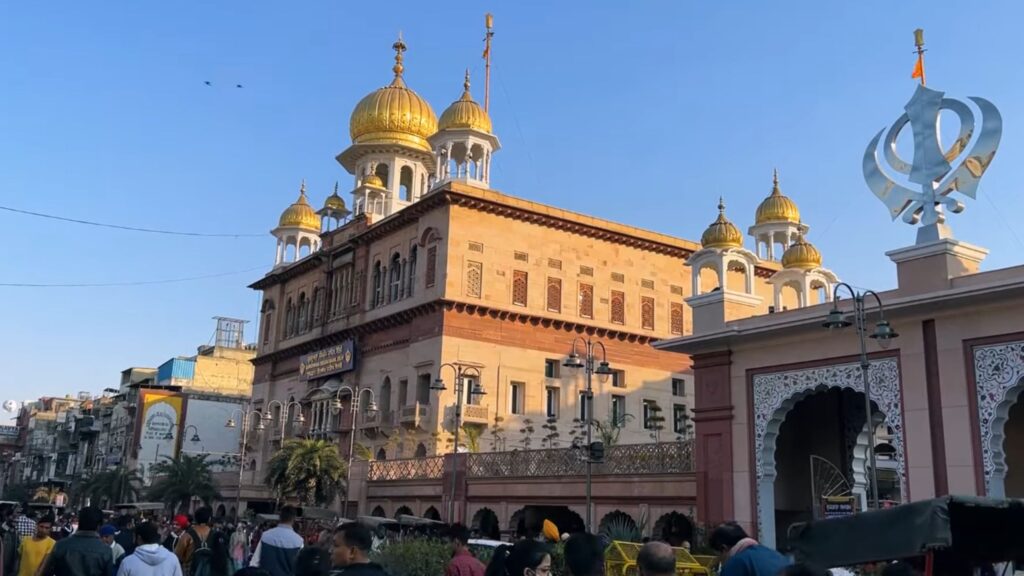Humayun’s Tomb, a precursor to the Taj Mahal, stands as a profound expression of a wife’s love for her late husband. Built in the mid-16th century by Haji Begum, the Persian-born first wife of Mughal Emperor Humayun, it is a masterpiece that seamlessly blends Persian and Mughal architectural elements. Tomb’s striking facade, a harmonious interplay of red sandstone and white marble, appears to float against the sky, a sight that has inspired awe and wonder for centuries.

Humayun’s Tomb Information:
Humayun Tomb Location:
Nestled in the Nizamuddin East area of New Delhi, the tomb sits near the dargah of the revered Sufi saint, Nizamuddin Auliya.
Status: NESCO World Heritage Site, it is the first grand structure to utilize red sandstone at such a scale.
Construction: Initiated in 1565, nine years after Humayun’s death, and completed in 1572, the tomb was envisioned by Haji Begum who spent her remaining years dedicated to its creation.
Architect: Design was entrusted to Mirak Mirza Ghiyas from Herat, Afghanistan, and upon his death, completed by his son.
Humayun Tomb History
Humayun’s Tomb, a UNESCO World Heritage Site in Delhi, is a magnificent symbol of Mughal architecture and history. Commissioned by Empress Bega Begum, Humayun’s chief consort, the tomb was built in 1565, nine years after the emperor’s death. Bega Begum’s vision was to create a grand mausoleum to honor her husband’s memory, leading to the first garden-tomb in the Indian subcontinent.
Humayun Tomb Architecture
Humayun’s Tomb stands as a testament to the grandeur and elegance of Mughal architecture, marking a significant evolution in the architectural landscape of India. Commissioned by Empress Bega Begum in 1565, the tomb was designed by the Persian architect Mirak Mirza Ghiyas. It was the first garden-tomb on the Indian subcontinent, setting a precedent for subsequent Mughal architecture, including the iconic Taj Mahal.
Humayun Tomb Entry Fees:
Accessible through two towering double-storeyed gateways to the south and west, each standing 16 meters tall.
Visiting Details Humayun Tomb:
Humayun’s Tomb Timings
Humayun’s Tomb visiting hours are between sunrise and sunset.
Humayun’s Tomb Address
Mathura Road, Opposite Nizamuddin Dargah, New Delhi – 110013
Humayun’s Tomb Opening Days
Humayun’s Tomb is open on all days of the week.
How to Reach Humayun Tomb?
Navigating to Humayun’s Tomb, nestled in the upscale neighborhood of South Delhi, is a breeze with the city’s excellent public transportation system. How you can reach this architectural marvel:
By Metro: JLN Stadium station on the Purple Line is the nearest metro stop, just 2 km away. An auto-rickshaw ride or a pleasant walk will get you to the tomb in no time. Alternatively, the Jorbagh station on the Yellow Line is about 5 km away, a short taxi ride from the tomb.
By Bus: Delhi Transport Corporation (DTC) operates several bus routes that stop near Humayun’s Tomb. Look for buses numbered 447 or 966B, which stop at Delhi Public School, a mere 5-minute walk from the tomb. Other nearby bus stops include those served by buses 19, ML-77, 166, and 181 at the Nizamuddin Police Station, roughly 900 meters away.
By Train: Nizamuddin Railway Station is the closest rail link, approximately 2.2 km from the tomb. You’ll find plenty of auto-rickshaws ready to whisk you away to your destination.
By Air: For those flying into Delhi, the Indira Gandhi International Airport is about 25 km from Humayun’s Tomb. A taxi can comfortably get you to the tomb in under an hour.
Humayun Tomb Photos


Humayun Tomb Nearby Places
Humayun’s Tomb complex is a microcosm of Mughal architecture and history, housing several significant monuments that offer a glimpse into the era’s grandeur:
- Tomb and Mosque of Isa Khan: Octagonal tomb, surrounded by an equally shaped garden, belongs to Isa Khan Niyazi, an Afghan noble from Sher Shah Suri’s court. Predating Humayun’s Tomb by two decades, it includes a mosque and is noted for its influence on later Mughal architecture.
- Nila Gumbad: Known for its striking blue-glazed tiles, the Nila Gumbad stands just outside the main complex. It was built for Miyan Fahim, a favored servant in Akbar’s court, and is distinguished by its octagonal exterior and square interior with painted plaster walls.
- Chillah Nizamuddin Auliya: To the northeast of the main mausoleum lies this structure, a fine example of Tughlaq architecture, believed to have been the residence of the saint Nizamuddin Auliya.
- Barber’s Tomb (Nai ka Gumbad): Situated within the Charbagh of the main tomb complex, this structure dates back to 1590-91 CE and is the resting place of Humayun’s royal barber, reflecting his esteemed position in the Mughal court.
Delhi’s rich tapestry of Mughal history can be further explored by visiting other iconic sites such as the Red Fort, Jama Masjid, Purana Qila, Safdarjung Tomb, and the bustling streets of Chandni Chowk, each narrating its own story of the Mughal era’s splendor.
Frequently Asked Questions (Faq)
Who constructed Humayun’s Tomb and why?
Humayun’s Tomb was constructed under the orders of Hamida Banu Begum, Emperor Humayun’s widow. The chief architect was Mirak Mirza Ghiyath, a Persian architect chosen by the queen. The construction began in 1565, nine years after Humayun’s death, and was completed in 1572.
Why is Humayun’s Tomb famous?
Humayun’s Tomb is renowned for being the first garden-tomb on the Indian subcontinent, a UNESCO World Heritage Site, and an outstanding example of Mughal architecture. It is also significant for its influence on later monumental Mughal architecture, notably the Taj Mahal.
What is the entry fee for Humayun’s Tomb?
Entry fee for Indian nationals and visitors from SAARC and BIMSTEC countries is INR 35. For other foreign visitors, the fee is INR 550. Entry is free for children under 15 years of age. There is an additional charge of INR 25 for carrying a video camera.
What are the visiting hours for Humayun’s Tomb?
Humayun’s Tomb is open from sunrise to sunset, typically from 6:00 am to 6:00 pm.
How can I reach Humayun’s Tomb?
Nearest airport is Indira Gandhi International Airport, 15 km away. Closest railway station is Hazrat Nizamuddin Railway Station, just 2.5 km away. The nearest bus stand is Dargah Hazrat Nizamuddin, 800 meters away. Closest metro stations are Jor Bagh on the Yellow Line and JLN Stadium on the Violet Line.










